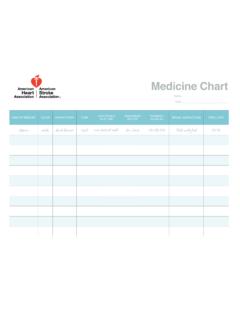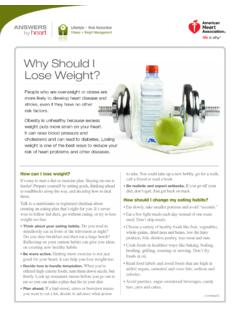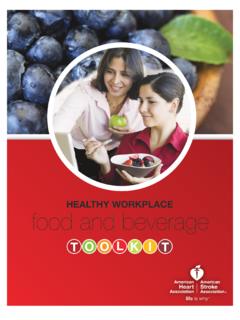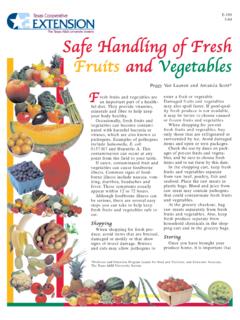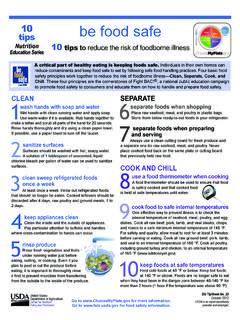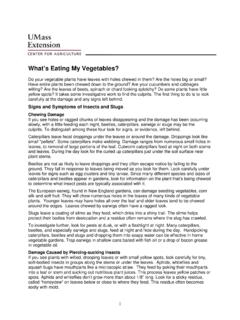Transcription of Fruits and vegetables are a key part of an
1 Fruits and vegetables are a key part of an overall healthy eating plan. They re also delicious, colorful, versatile, convenient, affordable and fun. This guide includes great tips and recipes to help you eat plenty of heart-healthy Fruits and You ll Find in this Guide: How to Eat More Fruits and VegetablesWhat s a Serving?Know Your NutrientsSeasons of EatingGet FreshBudget BasicsHealthy PreparationMastering the MythsRecipes Asian Marinated vegetable Salad Spaghetti Squash SpaghettiKids Zone Fun Facts Monthly Calendar fruit and Veggie Challenge2 How to Eat More Fruits and VegetablesYou can include more Fruits and vegetables in your diet in countless ways.
2 Try some of these practical tips that don t require a lot of changes to the way your family eats: Pack portable, easy-to-eat Fruits and veggies in your work or school bag, and avoid vending machine temptations. Add frozen peas or broccoli to rice when it s almost done cooking. Add extra veggies to soups and stews. Try a meatless meal once a week. Think vegetable lasagna, Portobello mushroom burgers or grilled veggie kabobs. Fill out a sandwich with Fruits and veggies. Try sliced or shredded vegetables like beets, carrots, celery, cucumbers, onions, peppers, radishes, tomatoes and zucchini and/or sliced Fruits like apple, avocado and pear.
3 Keep frozen and canned Fruits and vegetables on hand for when you need to throw together a meal in a hurry. Compare food labels and choose items without sauces and too much sodium. Work Fruits and vegetables into your family s favorite dishes. Make adding Fruits and veggies to meals a snap by cutting them up and keeping them in the fridge. They ll also be handy for snacking! When eating out, ask if you can substitute a fruit cup or side salad for fries and other less-healthy sides. Top yogurt, oatmeal and cereal with berries or sliced fruit . Make fruit popsicles. Freeze 100 percent juice in an ice tray or popsicle mold.
4 Add spinach, peppers or mushrooms into scrambled eggs and omelets. For snack time, keep fresh fruit and pre-chopped or no-chop veggies (such as baby carrots, cherry tomatoes and sugar snap peas) on hand, as well as single-serve containers of raisins or applesauce. Your kids are more likely to grab Fruits and veggies over other items if they re readily available. Enjoy fruit for dessert most days and limit traditional desserts to special occasions. Make it fun for kids to try new Fruits and veggies. Let them pick out a new fruit or vegetable in the grocery store each week, and figure out together how to cook or prepare it.
5 You might end up expanding your palate as well! Eat the rainbow: A fun and tasty way to make sure your family is eating a good variety of Fruits and vegetables is to eat as many different colors as you can each day. Keep a bowl of whole fruit handy on the desk, table or s a Serving The good news is eating the right amount of Fruits and vegetables doesn t have to be complicated. Find the approximate serving sizes for some of your favorites: *based on a 2,000 calorie eating patternVEGETABLES4-5 servings per day4-5 servings per dayONE MEDIUM fruit serving sizeserving sizeRAW LEAFY VEGETABLEFRESH, FROZEN OR CANNED VEGETABLEVEGETABLE JUICE CUPDRIED FRUITR aisinsFRESH, FROZEN OR CANNED fruit CUPFRUIT JUICE CUP CUP CUP1 CUPFRUITSF ruitsApple, pear, orange, peach or nectarine: 1 mediumAvocado: Half of a medium Banana: 1 small (about 6 inches long)Blackberry, blueberry: 8-10 medium to large Grapefruit: Half of a medium (4 inches across)Grape: 16 Kiwifruit: 1 mediumMango.
6 Half of a mediumMelon: Half-inch thick wedge of sliced watermelon, honeydew, cantaloupePineapple: of a mediumPlum: 1 large Strawberry: 4 largeVegetablesBell pepper: Half of a largeBroccoli or cauliflower: 5-8 floretsCarrot: 6 baby or 1 whole medium (6-7 inches long)Celery: 1 stalkCorn: 1 small ear (6 inches long) or half of a large ear (8 to 9 inches long)Cucumber: of a medium (8 to 9 inches long)Green bean: About 19-20 Leafy vegetable : 1 cup raw or cup cooked (lettuce, kale, spinach, greens)Potato: Half of a medium (2 to 3 inches across) Squash, yellow: Half of a smallSweet potato: Half of a large (2 inches across) Zucchini: Half of a large (7 to 8 inches long)3 Know Your Nutrients Fruits and vegetables are an important part of an overall healthy eating plan because they re typically high in vitamins, minerals and fiber and low in calories and saturated fat.
7 Most Fruits and vegetables also have no or little sodium. Eating a variety of Fruits and vegetables may help you control your weight and blood pressure and reduce your risk of heart disease and stroke. The vitamins and minerals also help your body with many daily It s Importantsome Good choicesCalciumPlays a key role in bone and tooth health and may reduce the risk of osteoporosis. Collard greens, kale, mustard greens, spinach, turnip greensFiberAids digestion and provides a feeling of fullness on fewer calories. A fiber-rich diet may help reduce cholesterol levels, maintain blood sugar and reduce the risk of heart disease and some types of , artichoke, banana, blackberry, blueberry, broccoli, green bean, kiwifruit, orange, pear, raspberry, spinach, sweet potatoPotassiumHelps maintain normal cell function and blood pressure.
8 Potassium deficiency can increase risk of kidney stones, cardiovascular disease and , broccoli, kiwifruit, sweet potato, white potatoVitamin CEssential for collagen formation, which is important for healthy skin. Helps carry oxygen throughout the , cantaloupe, cauliflower, kale, kiwifruit, orange, mango, pineapple, red and green pepper, strawberry, sweet potato4 Seasons of EatingYour heart-healthy recipes will taste even better with seasonal produce. Keep t hese tips in mind when using and shopping for seasonal pr oduce:Fresh foods are often less expensive during their harvest season. You may even save money by buying in bulk.
9 Shop the farmers market to learn more about produce and get ideas on how to prepare foods in season. Gardening gives you fresh seasonal produce and a little exercise, too. The sense of accomplishment you ll feel will make that produce taste even better! Frozen, canned and dried Fruits and vegetables also can be healthy choices. Compare food labels and choose items with the lowest amounts of sodium and added sugars. Choose canned fruit packed in water, its own juice or light syrup (avoid heavy syrup). Choose canned and frozen vegetables without sauces that can be high in sodium and saturated fat. Freeze fresh produce at the peak of its season, so you can add it to smoothies, soups and breads and enjoy it throughout the ALLWINTER artichokes, asparagus, carrots, chives, fava beans, green onions, leeks, lettuce, parsnips, peas, radishes, rhubarb and Swiss chardberries, corn, cucumbers, eggplant, figs, garlic, grapes, green beans, melons, peppers (sweet and hot), stone fruit (apricots, cherries, nectarines, peaches, plums), summer squash, tomatoes and zucchiniapples, Brussels sprouts, dates, hard squash (acorn, butternut, spaghetti)
10 , pears, pumpkins and sweet potatoesbok choy, broccoli, cauliflower, celery, citrus fruit (clementines, grapefruit, lemons, limes, oranges, tangerines), collard greens, endive, leafy greens (collards, kale, mustard greens, spinach) and root vegetables (beets, turnips)5 Always refrigerate cut or peeled temperature should be at 40 F or t wash, cut or peel until you re ready to eat (except lettuce and greens). KEEP THEM APART: Fruits like apples, bananas and pears give off ethylene gas, which can make other produce ripen and rot faster. Store vegetables and Fruits separately. Keep apples, bananas, broccoli, cauliflower, cucumbers, onions, pears, potatoes and watermelon away from other your pr oduce and dol lars by knowing how t o st ore fresh Fruits and away in a cool, dar k place like your pantry or cel lar:ONIONS, GARLIC & SHALLOTSHARD SQUASH (Winter, Acorn, Spaghetti, Butternut)SWEET POTATOES, POTATOES, & YAMSWATERMELONPANTRY12St ore loose and away fr om sunlight , heat and moisture:BANANAS CITRUS Fruits tore lemons, limes, oranges and grapefruit loose or in a mesh bag.

